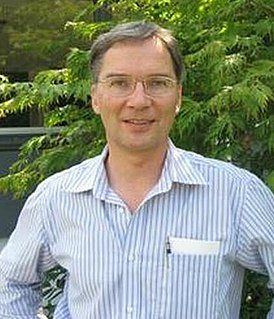
Algebraic number theory is a branch of number theory that uses the techniques of abstract algebra to study the integers, rational numbers, and their generalizations. Number-theoretic questions are expressed in terms of properties of algebraic objects such as algebraic number fields and their rings of integers, finite fields, and function fields. These properties, such as whether a ring admits unique factorization, the behavior of ideals, and the Galois groups of fields, can resolve questions of primary importance in number theory, like the existence of solutions to Diophantine equations.
In number theory, Iwasawa theory is the study of objects of arithmetic interest over infinite towers of number fields. It began as a Galois module theory of ideal class groups, initiated by Kenkichi Iwasawa (1959), as part of the theory of cyclotomic fields. In the early 1970s, Barry Mazur considered generalizations of Iwasawa theory to abelian varieties. More recently, Ralph Greenberg has proposed an Iwasawa theory for motives.
In mathematics, Dirichlet's unit theorem is a basic result in algebraic number theory due to Peter Gustav Lejeune Dirichlet. It determines the rank of the group of units in the ring OK of algebraic integers of a number field K. The regulator is a positive real number that determines how "dense" the units are.
In mathematics, a Galois module is a G-module, with G being the Galois group of some extension of fields. The term Galois representation is frequently used when the G-module is a vector space over a field or a free module over a ring in representation theory, but can also be used as a synonym for G-module. The study of Galois modules for extensions of local or global fields and their group cohomology is an important tool in number theory.
In mathematics, Galois cohomology is the study of the group cohomology of Galois modules, that is, the application of homological algebra to modules for Galois groups. A Galois group G associated to a field extension L/K acts in a natural way on some abelian groups, for example those constructed directly from L, but also through other Galois representations that may be derived by more abstract means. Galois cohomology accounts for the way in which taking Galois-invariant elements fails to be an exact functor.
In mathematics, Artin–Schreier theory is a branch of Galois theory, specifically a positive characteristic analogue of Kummer theory, for Galois extensions of degree equal to the characteristic p. Artin and Schreier (1927) introduced Artin–Schreier theory for extensions of prime degree p, and Witt (1936) generalized it to extensions of prime power degree pn.

In mathematics, the absolute Galois groupGK of a field K is the Galois group of Ksep over K, where Ksep is a separable closure of K. Alternatively it is the group of all automorphisms of the algebraic closure of K that fix K. The absolute Galois group is well-defined up to inner automorphism. It is a profinite group.
In mathematics, field arithmetic is a subject that studies the interrelations between arithmetic properties of a field and its absolute Galois group. It is an interdisciplinary subject as it uses tools from algebraic number theory, arithmetic geometry, algebraic geometry, model theory, the theory of finite groups and of profinite groups.

Jürgen Neukirch was a German mathematician known for his work on algebraic number theory.

Papyrus 40, designated by 𝔓40, is an early copy of the New Testament in Greek. The manuscript paleographically has been assigned to the 3rd century.
In algebraic number theory, Leopoldt's conjecture, introduced by H.-W. Leopoldt, states that the p-adic regulator of a number field does not vanish. The p-adic regulator is an analogue of the usual regulator defined using p-adic logarithms instead of the usual logarithms, introduced by H.-W. Leopoldt (1962).
In number theory, more specifically in p-adic analysis, Krasner's lemma is a basic result relating the topology of a complete non-archimedean field to its algebraic extensions.
In mathematics, the inflation-restriction exact sequence is an exact sequence occurring in group cohomology and is a special case of the five-term exact sequence arising from the study of spectral sequences.

Christopher Deninger is a German mathematician at the University of Münster. Deninger's research focuses on arithmetic geometry, including applications to L-functions.
In mathematics, Tate duality or Poitou–Tate duality is a duality theorem for Galois cohomology groups of modules over the Galois group of an algebraic number field or local field, introduced by John Tate (1962) and Georges Poitou (1967).
In algebraic topology, a transgression map is a way to transfer cohomology classes. It occurs, for example in the inflation-restriction exact sequence in group cohomology, and in integration in fibers. It also naturally arises in many spectral sequences; see spectral sequence#Edge maps and transgressions.

Peter Roquette is a German mathematician working in algebraic geometry, algebra, and number theory. He was born in Königsberg.

Uwe Jannsen is a German mathematician, specializing in algebra, algebraic number theory, and algebraic geometry.

Gunter Malle is a German mathematician, specializing in group theory, representation theory of finite groups, and number theory.
Alexander Schmidt is a German mathematician at the University of Heidelberg. His research interests include algebraic number theory and algebraic geometry.








